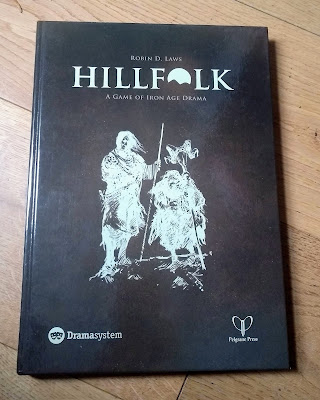I’ve run five or six sessions of one-shot Hillfolk/DramaSystem now, and I’ve never given dramatic poles much attention.
Mechanically, they don’t do much. Their interaction with the rules only occurs at the end of a session.
According to the rules:
At the end of each episode, each player in turn (in seating order) makes a brief statement, highlighting how he entertainingly brought out his character’s dramatic poles over the course of the episode, in relation to the episode’s theme.
Any story with a theme inherently includes the opposite of that theme. A story about war is also about peace; a story about hunger is also about nourishment; and a story about love also threatens the possibility of lost love. Therefore, you can describe your character as either reinforcing or undermining the theme.
You might describe yourself moving from one pole to the other, or bringing both poles into your characterization at different points.
…
All participants then vote, ranking the other players in order, with #1 the best score, #2 second best and so on. The argument is just a reminder: voters base their rankings on how well the players brought out their dramatic poles in relation to the theme, not how skillfully they made their cases. Moving from one pole to another in the course of an episode is a good thing. Vote against players who, episode in and episode out, stress a particular pole and ignore the other. Players do not rank themselves. No one ranks the GM, who never gets bennies. The GM votes, too, ranking all of the players.
The GM then totals each player’s vote tally. The number of drama tokens a player has in hand is then subtracted from this number.
The two players with the lowest scores gain one bennie each.
Bennies are the campaign currency, and are kind of like super drama tokens. In a one-shot they’re worthless, of course.
And so, as a result, I hadn’t paid dramatic poles much attention.
However, I now think that was a mistake.
DramaSystem and Furnace
A couple of things happened at Furnace when I ran Success2Soon, my pop group playset.
First, Paul Baldowski was playing and joked that he felt that Robin Laws specialised in designing RPGs that fixed things in gaming that didn’t need fixing. In Hillfolk’s case, it’s challenging players who say, “My character would never do that.”
Second, at the end of the game, I asked the players to highlight how they brought out their dramatic poles over the course of the session. And we voted on them, with the person with the most votes “winning”.
That was interesting, and worth doing again. But next time I run a DramaSystem game, I’m going to emphasise dramatic poles even more.
Because they help roleplaying.
“She’s rich…”
The example I always use of a dramatic scene is in Star Wars (as I still think of it), or to give it its full title, Star Wars Episode IV: A New Hope.
We’re on the Death Star, and Artoo has just told Luke that Leia is in the detention centre. Luke tries to persuade Han to help him rescue Leia. It’s a dramatic scene – Luke is the petitioner, and Han is the granter.
Luke initially fails, but eventually succeeds by appealing to one of Han’s dramatic poles: money (paying off the bounty on his head). Han’s other dramatic pole at this point is loyalty to his friend, Chewbacca.
(Luke’s dramatic poles, on the other hand, are duty [responsibility to his uncle and aunt] versus adventure [running off with Ben to join the rebellion].)
My character would do that
Dramatic poles help explain why characters do things that appear to be against their self-interest (like sneaking into the detention centre in the heart of the Death Star).
And that’s why there’s space on the character sheet for other character’s dramatic poles. It means you can use them when petitioning, and help create the drama.
And another thing: procedural scenes
While I’m on the subject of Hillfolk, I stumbled across this AMA on Reddit. To save you the effort of wading through the questions, I found an interesting point about the design of Hillfolk’s procedural system (which seems clunky written down, but works fine in practice).
Question: Hillfolk is a game I have been wanting to play for a long time now, as soon as I can find the right group for it. The procedural resolution rules seem to be quite a divisive subject among players. Were there any particular design considerations that led you to implement the system the way that you did? What kind of impact do you feel that replacing the procedural resolution rules with rules from another system (as many people seem to do) would have on Hillfolk's overall gameplay?
Robin’s answer: The procedural system is designed to do what it needs to do without pulling focus from the central feature of the game, the dramatic scenes.
Because drama is more about dealing with the repercussions of disaster than chalking up wins, the system also imposes a much higher failure rate than you'd tolerate in the procedural-focused games we're all used to.
So if you replace it with a rules system you find aesthetically alluring and like to play around with, you'll likely:
a) call too many procedural scenes
b) succeed too often at them
(Remember that if everyone wants to succeed, you just say you did, with narration, and then get back to the interpersonal interactions.)
Which I found interesting. Hillfolk’s procedural system is harder because in a dramatic game, failure is more interesting than success. I wish the rules actually said that.
Next time on Hillfolk
So next time when I run Hillfolk I will:
- Make sure dramatic poles get the emphasis they deserve.
- Stress that the procedural system is tough because failure is more interesting than success.
(And next time will probably be at Consequences, at the end of November.)

No comments:
Post a Comment